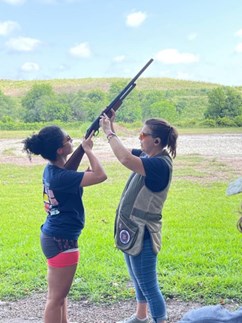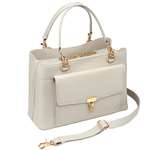
As an NRA Firearm Training Instructor, I deal with a lot of issues among my students. Some students must get over their fear of guns, while others need to get over the disinformation they hear from the media regarding gun owners. The most common issue I address is hesitation from felt recoil. This is not unique to only my students; most instructors will tell you that recoil is the most common obstacle students overcome.
First, though, instructors must understand where excessive felt recoil originates before they can address it with their students. Excessive recoil is sometimes caused by the gun, and sometimes it is caused by the shooter. It is also important to remember that there are some individuals who don’t mind recoil, and while others do. Instructors must know how to tell these individuals apart.
Excessive recoil that is caused by the gun goes hand-in-hand with someone who does not like recoil. It takes “tough love” to help this type of student. For some individuals, hearing that they have “too much gun” and they need to consider a smaller caliber can be a tough pill to swallow. Some individuals equate this with an attack on their manhood, so it’s imperative to let students keep their pride intact while finding a gun that they can handle.
I once received an e-mail from an individual inquiring about one of my upcoming NRA Basic Pistol classes. The e-mail started out in the usual way, stating that he was looking for a basic pistol class so that he could improve his marksmanship skills. Then, red flags started to show when he stated that he had already taken three other NRA Basic Pistol Classes from three different instructors but could not pass the shooting portion—three times! I would be the fourth class and his fourth instructor. The e-mail then took a turn when he began ranting about the type of large-caliber pistol he carried. Not wanting him to waste more money on a class that would probably not achieve his goals, I responded by suggesting he may want to consider a smaller caliber firearm such as a 9 mm. I never heard back from him.
Then there are those whose excessive recoil issues can be attributed to themselves. These individuals do not mind the recoil, but it affects their marksmanship. These are issues that can be corrected with proper instruction. This is where the instructor must use his or her skills to identify the problems and correct them so the student gets the proper training they are expecting.

Proper Gun Fit
Proper gun fit is essential for shooter comfort. A firearm that does not fit the shooter will have more felt recoil than a gun that fits. For example, with a shotgun, a shooter who cannot properly mount the firearm may not be able to pull the butt of the shotgun or rifle snuggly into the shoulder, which will likely result in a painful bruise.
Proper shotgun fit includes stock length, overall firearm length, and overall firearm weight. Check the proper stock length of your firearm by placing the butt of the gun into your bent elbow with the muzzle facing skyward. Then reach up with your index finger to see if it fits into the trigger guard and comfortably on the trigger. If your finger does not comfortably reach the trigger, you need to take your firearm to a gun fitter to have the stock fitted to your mount and comfort. For shotguns, overall length and weight is finding the right specifications that allows for an even and steady swing onto the target.
Proper Hold
The proper hold on your firearm does several things. It is essential for following the 5 Fundamentals of Shooting (aiming, breath control, hold control, trigger control, follow through) and it allows the shooter to maintain control of the firearm while it is cycling the spent cartridges out and loading a new round into the chamber. A proper hold is what ties the gun and the shooter together.

Without a proper hold, the firearm can jerk back toward the shooter making the felt recoil seem much worse than it actually is. A proper hold gives a firearm, such as a pistol, a firm base to operate. When the firearm has a firm base to operate, the recoil is directed to the gun and not the shooter. In other words, the recoil is absorbed by the gun and not by the shooter.
Heavier Gun
Most firearms manufacturers offer different models to meet the different needs of each shooter. Most manufacturers offer lightweight versions of their popular rifle, shotgun and handgun models. The consumer must realize that there is a tradeoff with lightweight guns and recoil. The lighter firearms are easier to carry over long distances but can produce a lot more felt recoil compared to the same gun in a heavier model.
When most consumers are at the gun store and handling different firearms, the lightweight models sure are appealing! When you hold a 9-lb. rifle, then the salesman swaps it for a lightweight 6.5-lb. rifle, it is easy to understand why the lighter rifle is purchased. The same goes for shotguns and handguns. Just remember, some firearms are made for carrying and not shooting. Some lightweight conceal carry firearms are not meant to be taken to the range and used with a full box of ammo. Obviously, shoot it a few times so you are comfortable, but if you are going to be doing a lot of shooting, go heavier.
Lighter Ammunition
Many of the common calibers have a variety of loads for the shooter to choose from. Heavier bullets and higher muzzle velocities can drastically increase felt recoil. So, if there is a popular caliber that you want to shoot but do not like the recoil, there might be options for you. Do your research before giving up your favorite gun.
Fortunately, many manufacturers produce “Reduced Recoil” ammunition. Reduced Recoil ammunition are lighter bullets and loaded with gun powder on the lower end of the scale for that caliber. For example, Remington makes a .30-06 Springfield Managed Recoil Core-Lokt ammunition with a 125-gr. bullet with a muzzle velocity of 2,660 feet per second, and a .30-06 Springfield Core-Lokt ammunition with a 125-gr. bullet with a muzzle velocity of 3,140 feet per second. As you can see, the regular ammunition is exiting the muzzle at a much higher velocity. This equates to much more felt recoil.














































